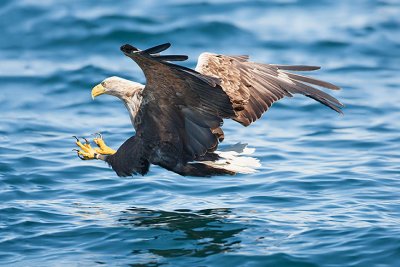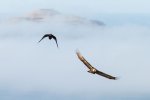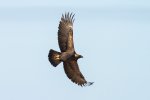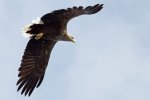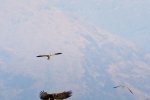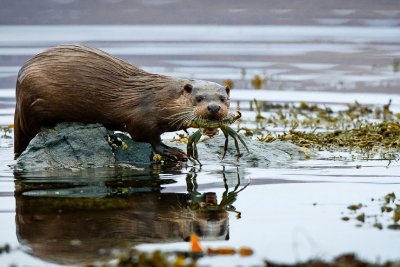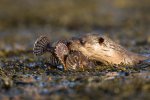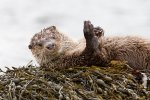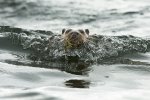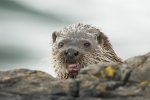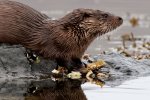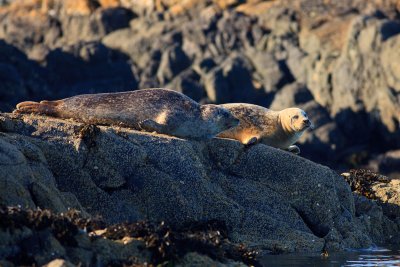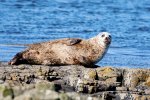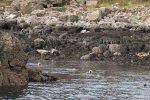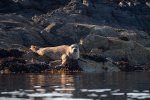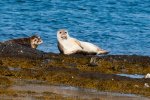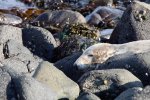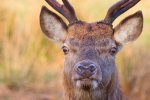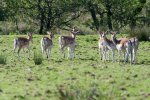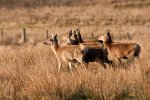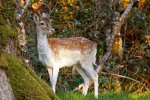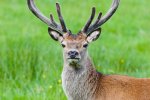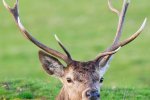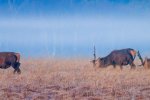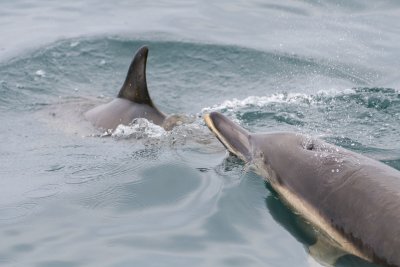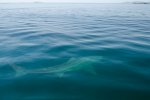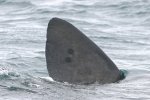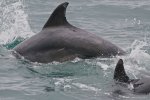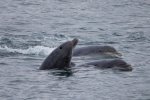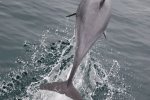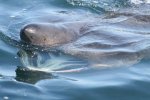Eagles
Mull isn't called 'Eagle Island' for nothing.
It boasts one of the densest populations of breeding golden eagles - in the world. Often known as the 'King of Birds' and often thought of as 'Scotland's National Bird', a golden eagle is the number one species which birders and general visitors alike want to see above all else. And you can see why. The word 'majestic' was clearly invented for golden eagles. The golden nape, the sleek, swept-back wings and the dramatic roller-coaster display flights make this one of the planet's most inspiring birds of prey. In some parts of their world range they can be elusive and difficult to see. On Mull, it's a rare holiday week when a golden eagle is not seen. But not just glimpsed in the far distance as it soars off over a ridge. Some pairs here occupy home ranges close to quiet island roads and viewpoints and there is the unique opportunity to not just glimpse them but to watch, study and learn. Quality views. Many of Mull's crags and peaks are named in Gaelic as 'eagle rock' or 'eagle crag'. They have been here for centuries. They define this ancient land and belong to it. They are here for you to discover.
On an even bigger scale, there is another eagle which equally belongs here but was once taken from us for 100 years: the white-tailed or sea eagle. Although they were never reintroduced to Mull, they soon discovered our island from nearby Rum and liked what they found. Bountiful seabirds, fish and mammals with countless nesting opportunities and ancient sites still vacant since their extermination from these islands in the late 19th Century. They have been slowly re-colonising their historic homeland since the first pioneering pairs settled here in the early 1980s. Today, they are once again a familiar sight in our ever-changing skies and with a 2.5m wing span they are hard to miss. You may have seen them on the TV but even Springwatch can't really do these birds justice and you just have to see them for yourself - in the wild. If 'majestic' sums up golden eagles, perhaps 'awesome' is right for sea eagles: they are certainly awe inspiring. They command the thermals, soaring on broad, flat wings with a Persil-white tail gleaming in the sun. The 'eagle with the sunlit eye' really will take your breath away. You will never forget your first time.
Otters
If Mull can be proud of one of the highest densities of eagles in Europe, the same can also be said of otters. At the top of everyone's list of mammals they dream of seeing in the UK, our otters here are thriving and you stand a very good chance of seeing one during your holiday break on Mull. But you have to do it carefully…and responsibly and the otters will repay you handsomely for your patience.
A guided tour may well be your best chance of spotting one as the experienced guides and drivers know their local otters well: what state of the tide is best; what time of day; secret coves and distant reefs where they rest, all but hidden amongst the bladderwrack. If you're on your own, find a likely stretch of rocky coast, locate a sheltered cluster of boulders, hunker down…and wait…and watch. Maybe you'll get lucky, maybe you won't but it's the best and least disruptive way to otter watch. And if you are rewarded, you'll see otters relaxed and just doing what otters do best: fishing, exploring, snuffling, playing and sleeping. Watch for useful signs about otters at top hotspots and kill your speed on island roads. Now, that shape moving steadily through the water…is it an otter? Or is it a seal?
Seals
Mull is home to the Roman-nosed Atlantic grey seal and the harbour or common seal with a head like a Labrador. But some harbour seals look grey and some grey seals don't! This wildlife watching business can be confusing sometimes. An off-season visit to our wonderful islands can yield one of the world's great natural history spectacles. Grey seals breed on remote off shore islands in the autumn as storm force winds batter the wild coast. Helpless white pups with pleading, dewy eyes cry mournfully for their mothers to return safely from the foaming ocean while giant, lumbering bull seals thunder through the colonies looking for trouble…and a mate. Experienced skippers will take you close to this drama and it's a sight…and smell...you will remember forever.
In gentler June, the harbour seals have their pups on undisturbed offshore skerries but their pups must be ready to swim at the next high tide. No weeks of loafing about onshore for them. It's straight into the cold waters of the Atlantic and a struggle to stay safe and close to their mothers. Orcas sometimes hunt these waters; sea eagles scavenge where pups are born and only the fittest will survive. Many easy-going boat trips will encounter harbour seals all summer long and what better to way to wile away an afternoon than watching the seals doing the same, banana-shaped, snoozing, chilled.
Deer
The Monarch of the Glen is alive and well on Mull; red deer have roamed these rugged hills since long before early man discovered the appeal of the islands. Red deer regularly swim the narrows between them, from Mull to Ulva and back; across Salen Bay, with a shake of salty water on emerging the other side. You will see red deer from the road side or on long hikes into the glens. Some are used to being watched; some will scatter at the first sight or scent of you but you will see them. As the harbour seals have their pups in June by the coast, nervous red deer hinds are dropping their calves at the exact same time in the hills. Dainty and dappled, the new-born, calves totter unsteadily after their mothers but within a day or two can run like the wind and can usually out-manoeuvre any attacking eagle. Come the first frosts and gales of autumn, the stags gather their harems together and bellow from every forest glade and heather slope on the island. Forest rangers take you on dusk foot safaris to where you will feel the roars rumble through your core.
Lurking anxiously in gentler Mull pastures are fallow deer from Knock to Loch Buie. Dark ones, almost white ones and the familiar Bambi-like spotted ones, they are less easily spooked than their larger red cousins. The bucks palmate antlers are no less impressive but compared to the stag's autumn war cry, the fallow's croaking, belching rut is less likely to chill the blood.
Creatures of the deep
Perch atop a Mull coastal hillock on a calm summer's evening and simply gaze out to sea. Scan and squint and see what creatures of the deep reveal themselves for that split second before submerging again. With luck, patience and good fortune, you will see some of Mull's marine mammals and maybe, just maybe, the second largest fish in the world – the basking shark.
From land, you might spot the shark's nose tip, fin and tail, weaving and swaying just beneath the surface as it filters for microscopic plankton through its enormous and cavernous mouth and gills. But from a boat – or even in the water - these amazing creatures take on a different aura. The gentle giants of the sea will leave you breathless and humbled as they cruise past.
Then a shout from the crew shatters the silence and there's a minke whale surfacing just off the bow; a 'blow' and a ripple and it's gone again. Where and when will it resurface again? Some encounters are closer and longer as a curious individual seeks out the boat with its gawping occupants leaning and straining to see over the rail, staring longingly into the deep.
Also sighted here are massive pods of common dolphins, families of bottle-nosed dolphins, occasional small groups of Risso's dolphins and there are always the unobtrusive and under-rated harbour porpoises gently surfacing like a wheel turning and with their distinctive piggy snort.
Every now and then, social media lights up as news spread of orcas coasting past Glengorm or out at the Cairns of Coll. That evening, lucky, smiling, wind burnt faces return to Tobemory Harbour with a warm glow inside, knowing that they were in the right boat - at the right time.

